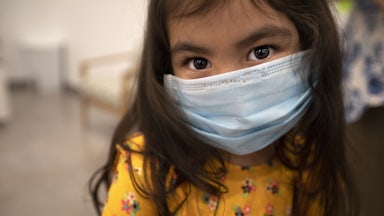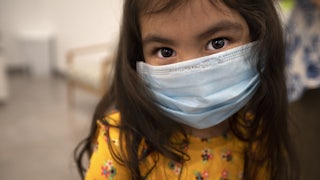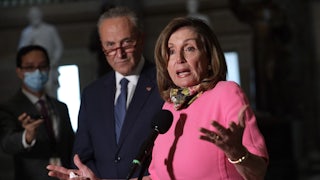Meredith Shiner’s son was born into the pandemic. Now at 19 months old, he’s too young to get vaccinated or wear a mask. As precautions began lifting in her city and across the country, she knew it was only a matter of time—but it didn’t take long. One Thursday night at the end of March, Shiner, a communications consultant in Chicago, received the dreaded day care email: A toddler in her son’s class had just tested positive. The next day, her son developed symptoms and tested positive as well. By that afternoon, he was sicker than she’d ever seen him.
“It was scary to see the kind of pain he was in,” Shiner told me. Even when the acute illness began to let up after several days, the toddler cried as he struggled to sleep each day. She rocked him endlessly, but he couldn’t be comforted. Food didn’t taste right, and he spat it out. All told, he tested positive for 12 days, during which time Shiner and her husband also got sick and lost weeks of work.
Their fear was eventually supplanted by rage. There was no contract tracing for the day care outbreak, so it was impossible to know how large it was, Shiner said, and her local health department wouldn’t release numbers on how many day care outbreaks or cases there were. “Why don’t we want to know the size and scope of these outbreaks?” she asked. Her own positive case was only reported to the health department after she took a confirmatory polymerase chain reaction (PCR) test following a positive home test. She took the extra test, she said, because she wanted the local numbers to be more accurate.
I’ve been tracking the numbers on Covid for nearly two and a half years now. And in some ways, I feel more lost and uncertain than I’ve ever felt. Early in the pandemic, I was convinced case numbers were much higher than those being confirmed by faulty and sparse tests. That conviction proved true. But now, I’m not as certain. Are we seeing a slight uptick with the BA.2 variant and its highly transmissible subvariants, as data from the U.S. Centers for Disease Control and Prevention indicate, or is it already a surge, as the many stories of acquaintances testing positive seem to suggest? The reality is, we just don’t have any way of knowing. With many people, as well as leaders, eager to move on and put Covid restrictions behind them, the data on Covid’s circulation throughout the nation has gotten much patchier.
“I feel like we’re standing on quicksand,” Carolyn Cannuscio, associate professor of family medicine and community health at the University of Pennsylvania, told me. “We can’t really believe the data we’re seeing. It’s harder than ever to compare the data across states, for example, and it’s hard to compare the data over time.” The first question epidemiologists like Cannuscio ask is whether one believes the data. “If your answer to that question is no, then you really are stuck. Good data is the foundation for public health.”
The numbers on Covid have always been inadequate, in part because not every case is confirmed with a test. But now, as more people turn to home tests and as uninsured people lose access to affordable testing, it’s even harder to know what’s going on. The Institute for Health Metrics and Evaluation estimates that the current numbers represent about 7 percent of actual cases. Many counties and cities don’t accept reporting of home tests, and even in places that do—like Washington, D.C.—unconfirmed tests are not included in the official tally of cases.
/ In honor of Earth Day, Apocalypse Soon content is free to registered users until April 29. Start reading now.
“People have successfully argued that our policies—for example, masking indoors—should change based on whether case counts are high or low,” Cannuscio said. But “we’ve altered our ways of measuring rates of disease in the population. So, it’s a dizzying time.”
Metrics like Covid hospitalizations or Covid deaths have changed in some places, too: Some states have begun reporting Covid hospitalizations only for those on the Covid-specific medications dexamethasone and remdesivir. That means patients who have other issues spurred by Covid—diabetic ketoacidosis, blood clots, early labor, and a number of other closely related ones—aren’t counted in those hospitalization tallies, even though the patients wouldn’t have been hospitalized had they not gotten Covid. Other states only count hospitalizations for patients who actively test positive for Covid, which means that those battling the effects of the virus in intensive care units who have been sick long enough that they’re no longer positive are uncounted. Some states also have changed the way they report Covid deaths. If we were to change definitions like these, it could help standardize data across states and municipalities, if all places were to adopt the same definition, but it might also cause Covid’s true death toll to be overlooked.
The CDC’s controversial change in focus from community transmission rates to hospital capacity was a misstep, experts told me. Having data on cases is important, in part because hospitalization rates are “a lagging indicator,” said Ajay Sethi, associate professor of population health sciences at the University of Wisconsin–Madison. Understanding the prevalence of Covid isn’t just important for determining our risk levels; it also helps hospitals brace for incoming surges. “If we stopped following cases because we didn’t think the data were representative enough, I think hospital administrations across the country would say, ‘Well, what are we supposed to use to determine whether there’s going to be a rise in hospitalizations?’”
Reporting on numbers like these has always been messy, experts say. With mortality, for instance, “we’re very good in the United States at ascertaining the fact of death. We are usually less certain about ascertaining the cause of death,” Cannuscio explained.
But it’s getting much worse, she added. “We are doing this all wrong. We are changing our definitions. We are changing our measurement strategies, we are testing less, we are eliminating easy access to testing for people who are poor or uninsured.”
Barriers to testing and not counting home tests messes up more than just the data: You can’t take Covid antivirals or monoclonal antibodies without an official positive test, and if your home test goes unreported, you may not have access to Covid relief measures, like food and medication delivery, transportation assistance, and links to housing opportunities for people who don’t have safe places to isolate. It was only after Shiner took the confirmatory PCR test that a social worker called to ask about symptoms and to offer mortgage, rental, and utility assistance—a call that never would’ve happened if she’d only taken the home test. “We’re keeping vulnerable people separated from some of these lifesaving conversations,” Shiner said, even with uninsured people now obligated to pay out of pocket for tests and treatments. Meanwhile, those who don’t report positive home tests to their doctor may face obstacles in qualifying for long Covid treatment and disability later on.
Though skeptical of some of the confirmed case numbers, Sethi is watching them closely, paying particular attention to rising cases in the Northeast, a region that has frequently been “a bellwether of what the rest of the country faces at some point,” he said. “That does help me interpret any local increase I see here in Wisconsin.” He looks less at the raw numbers and more at trends: Are cases going up, even if the total number is still lower than during past surges? What do vaccination and booster rates look like in a given community? This kind of data can also help inform people’s decisions.
Data on the virus showing up in municipal wastewater can be helpful, because it’s less controversial and dependent on individual behavior and access to testing. But it’s still a “blunt instrument” at this point, Cannuscio said. “Right now, what we can say is Covid is circulating; here are the variants that are circulating.” That doesn’t yet translate into how prevalent Covid is in a community or the extent to which it’s rising or falling. Other data points, like school and work absenteeism, can also be helpful predictors of surges in a community, Sethi said.
After her family’s Covid experience, Shiner is worried about the country’s headlong rush “back to normal,” as the shorthand goes: “We’ve refused to define what normal is and who is entitled to it,” she said. She has a “simmering dread” that her family’s experience is, in fact, our new normal—something families like hers will face every few months. She worries about all of the economic disruption—the parents who miss work, the children who miss school, the bills that mount up with each infection—and she fears for her son. “He’s 19 months old. He didn’t choose this world, but we are collectively as a society making these decisions for him.” Not everyone has a baby at home, but everyone has someone who is precious to them—yet we haven’t oriented our back-to-normal plans around those who matter to us and stand to lose the most.
“Every individual is going to have a different risk calculus,” Shiner said. “However, when we don’t provide accurate information to people who want to be able to evaluate their own risk—in this world in which you’ve decided that individual responsibility is a stand-in for public health—how are people even supposed to actually make the decisions that are right for them?”










